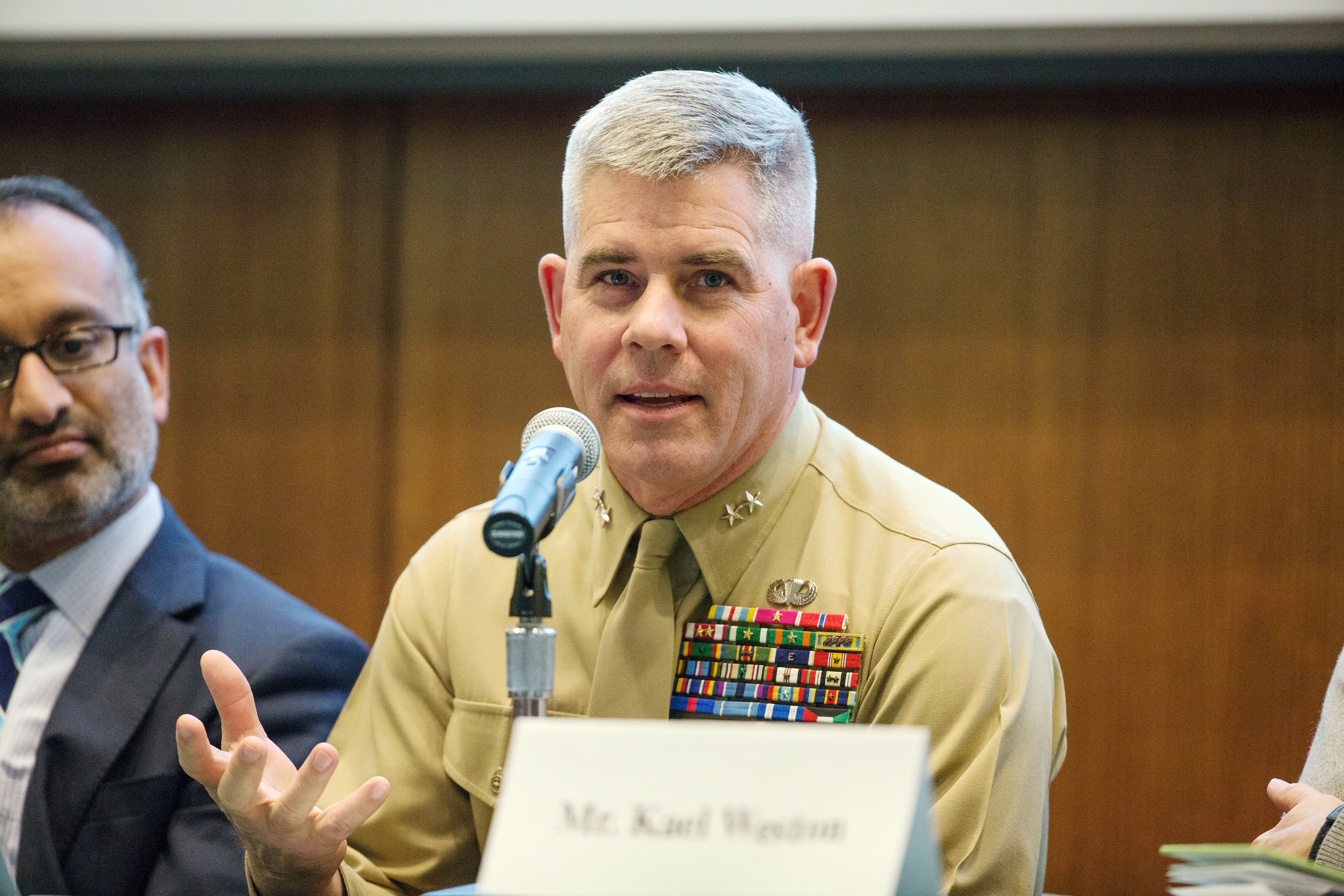MARINE CORPS BASE QUANTICO, Va. — A lot has changed in the five years since Marines fought in the Battle of Marjah, Afghanistan. Five years can change many things.
Many of the Marines who charged into the Taliban stronghold of Marjah, Afghanistan, as young lance corporals in 2010 are now bearded veterans with new careers and ambitions. The brass who led the invasion have either retired or added new stars to their crisp uniforms. Hundreds of them gathered here to commemorate the years that passed since the deadly battle
But the years and the changes fell away Feb. 12 as hundreds gathered here for as hundreds of Marjah veterans of Marjah gathered here for a two-day reunion, organized by several of the veterans themselves, to mark the anniversary of what has been called one of the most decisive victories of the war. The event was organized by several of the veterans themselves.
The significance of the small, southern town of Marjah was clear to commanders well before the 10ten-month siege on the town was launched in February. 2010. Overrun by insurgents, the region was called a "black hole" that stood adjacent to key locations such as Lashkar Gah, the capital city of Helmand province.
A joint assault called "Operation Moshtarak" — the name taken from the Dari word for "together" — was planned and launched as President Obama ordered a surge of 17,000 additional troops into Afghanistan. The battle was a heavily publicized in an effort to flush out civilian non-combatants, the attack on Marjah was also promoted to the Marines who led the charge. Comparisons were made to another key Marine fight: the two-part Battle of Fallujah, in Iraq.
Ultimately, the Battle of Marjah would involve 15,000 U.S., Afghan, and NATO troops in a lengthy and costly battle. Nearly 50 Americans would die supporting Operation Moshtarak.
"Marjah was one of the places that was advertised to us as the wicked problem, if you will," said retired Col. Randy Newman, former commander of Regimental Combat Team 7, the ground combat unit leading the assault. "We didn't fly aircraft over the top of it; we didn't go through it."
Newman spoke to an audience of mostly Marjah veterans Feb. 12 on a panel that included other key leaders of the assault.

Retired Marine Col. Randy Newman, former commanding officer of Regimental Combat Team 7, discusses Operation Moshtarak during a reunion for veterans who fought there.
Photo Credit: Mike Morones
Billed as professional military education and organized by Marine Capt. Wesley Jagoe, who went into Marjah as part of a motorized rifle platoon within 2nd Marine Expeditionary Brigade, the panel enabled leaders to examine the battle with the distance and perspective of time.
Newman was frank about the areas he considered failures of the battle. The Marines had planned to set up a brand-new civilian government infrastructure in Marjah following the defeat of Taliban forces, but the effort was labeled a failure by spring 2010. But Tthe concept of "government in a box" proved to be more difficult than expected, and especially challenging in Marjah, where coalition troops could only find one or two local men who met basic criteria they'd established for good leaders.
And the assault proved longer and more difficult than leaders had predicted, leading to impatience and frustration higher up the chain of command. Three months into Operation Moshtarak, Gen. Stanley McChrystal, then-top allied commander in Afghanistan, called Marjah "a bleeding ulcer" and warned that the clearing effort was proceeding too slowly.
The fault, said Newman, lay in unrealistic expectations projected at the outset, particularly considering Operation Moshtarak's focus on the slower strategy of counterinsurgency.
"We were in briefings hearing, 'wWhy were we so far behind?' And we thought we were ahead," he recalled. "I'll take the bust for that. I did a lousy job of building appropriate expectations."
But Marjah was also the scene of key innovations and turning points in the war, other commanders said.
It was the first major battleground that saw Afghans fighting alongside coalition troops in numbers.
"[The International Security Assistance Force] wanted to show that [the Afghan National Security Forces] could defeat the Taliban in their stronghold," said Maj. Gen. James Hartsell, 2nd MEB liaison officer to Regional Command-South during the Marjah campaign. "We had to show that the Afghans could defeat the Taliban, not that the Marines could."
Marjah was also the beginning of the Marines' use of village stability operations, said Maj. Gen. Joseph Osterman, who commanded 1st Marine Division (Forward) during the Marjah push. Those operations VSOs involved partnering with Afghan troops and leaders to empower them to protect themselves from enemy fighters.

Maj. Gen. Joseph Osterman, former commanding general of the 1st Marine Division, participates in a professional military education panel discussion about Operation Moshtarak and the Marjah campaign on Feb. 12.
Photo Credit: Mike Morones/Staff
Following the panel, groups of Marjah veterans huddled over beers as they reminisced and talked strategy. At a long table, young veterans clustered around Hartsell, engaged in a frank discussion that began with Marjah and stretched into Iraq, Syria and global foreign policy.
"So, is instability the new stability?" asked one Marine vet, former Sgt. Wesley Hillis.
"Yeah, it is," Hartsell replied.
The opportunity to hear directly from the men that sent him into the fight was not lost on Adam Thomas, 24, a former sergeant who left the Marine Corps in 2012.
Thomas, who traveled from Tennessee to be at the reunion, remembered being in his Camp Lejeune, North Carolina, barracks room and hearing President Barack Obama announce the surge in Afghanistan in December 2009. He knew then that his unit — Alpha Company, 1st Battalion, 6th Marines — was being sent to war.
"These were the guys that were moving us on the chessboard," he said, indicating the general officers in the room. "And at the time, I didn't know who they were."
That sense of common bond was one of the goals of the reunion, said Jagoe, who planned it with the assistance of the Marine Corps Association and Foundation and retired Col. Preston McLaughlin, chief of staff for 2nd MEB during Operation Moshtarak.
Jagoe said working closely with the MEB had given him a birds-eye perspective on the battle that wasn't available to the ground troops, and he wanted other vets to have the opportunity to understand the significance of their sacrifice in context. More importantly, he said, he wanted them to know that they had achieved victory and accomplished the mission.
"We keep hearing good news out of Marjah, and if it stays that way, then that's great," Jagoe said. "But even if it doesn't, we went there, we had a job, we did it. It was large-scale, it was unknown. There were thousands and thousands of [improvised explosive devices], but the Marines did it. And that's going to go down in the legacy books as a major successful battle."
For Hillis, 31, a veteran of Bravo Company, 1/6, there will always be lingering questions about the strategy that sent his unit into Marjah and later north to the Kajaki Dam in support of work on the project dam that was never completed. But when he thinks back on Marjah, a more poignant image comes to mind.
"I see these guys. I picture my company standing there," he said. "It's what's brought me back here. We had 300 guys who fought for each other regardless of race, color, and religion."
In coming years, Marjah Marines will have their own exhibit in the National Museum of the Marine Corps, part of a planned expansion expected to be completed by 2020.
One of the best-known Marjah Marines, Retired Cpl. Kyle Carpenter, told Marine Corps Times such an exhibit should be nuanced and should not shy away from the harsh realities of the fight. Carpenter received the Medal of Honor in June 2014 for covering a grenade to save another Marine while deployed to Marjah in 2010 with 2nd Battalion, 9th Marines. He addressed the roughly some 300 Marjah veterans Feb. 13 at a banquet that concluded the reunion.
"It should be pictures and stories," Carpenter said. "It should show the hard sacrifices and it should really paint a picture of what Marines went through. A lot of Marines died in Marjah. There's a lot of positive things we're doing, and a lot of, I guess you could say happy things that happened between the Marines and positive things that happened to us over there as far as our bond and just caring and looking out for each other.
"But I think it should show people just the unfortunate bad side of war and bad side of combat. It should be reality, it should be what we really went through."





